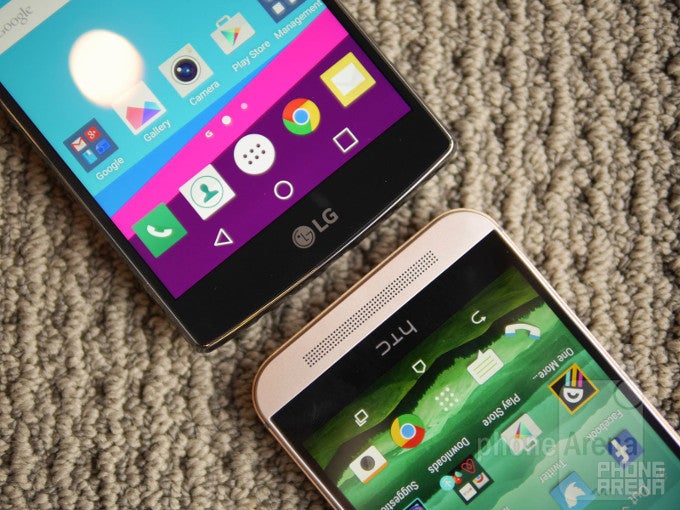LG G4 vs HTC One M9: first look

Design
The One M9 is a tad thicker than the G4, which is confirmed by your hand grip, but, being a 5" handset it is narrower, so a bit easier to handle with one palm only. Both The One M9 and LG G4 have onscreen navigation keys, but the M9's screen-to-body ratio is notably worse on account of the two large BoomSound stereo speakers with Dolby surround sound at the front. All in all, it is not of the compact kind, relative to the screen size, but the G4 is seemingly worse in that regard than the G3, too, though that still leaves it with better screen-to-phone percentage than the One M9.
Display
A 5" 1080p LCD vs a 5.5" Quad HD one - the playing field is not equal, but that's the clash in the display compartment. The 1080p LCD screen of the One M9 has the same footprint as the One (M8) - 5 inches. This results in a more than acceptable pixel density of 441ppi, though it's a little sub-par in terms of sharpness when we put it next to the Quad HD display that graces the G4. With a resolution of 1440 x 2560 pixels, the G4 flaunts the whopping 500+ppi pixel density. It's true that it will be quite hard to distinguish individual pixels on each display with the naked eye.
Regardless, in pure numbers the LG unit overshadows the HTC device with its properties. On top of that, our One M9 display quality measurements revealed that there is nothing extraordinary about it - neither in color accuracy, nor in brightness. On visual inspection, the G4's panel looks brighter, and with a bit livelier colors.
Flaunting HTC's SenseUI 7 with Android 5.0 Lollipop, the One M9 comes with almost the same UI feature set as the One (M8) with a few small additions. The Lollipop iteration of Sense bears a cleaner and more polished, Material Design-like UI, which feels more responsive and faster than ever.
Interface
Flaunting HTC's SenseUI 7 with Android 5.0 Lollipop, the One M9 comes with almost the same UI feature set as the One (M8) with a few small additions. The Lollipop iteration of Sense bears a cleaner and more polished, Material Design-like UI, which feels more responsive and faster than ever.
The LG UX 4.0 experience is lighter, too, and seemingly unchanged much from the previous UX version of LG. LG doesn’t follow the trend of providing themes that we’ve been seeing of late. LG's UX 4.0 looks as squarish and edgy as ever, in stark contrast with the beautiful round Sense UI. It is, however, stuffed to the gills with functions, toggles, and settings options for the smallest thing, despite the lack of theming choices.
Processor and memory
In terms of chipsets and interface fluidity, the One M9 has the upper hand, bar none. Its screeching fast Snapdragon 810 trumps the 808 of the G4, plus the new HTC Sense 7 UI is a beauty to watch transitioning. On the other hand, the 808 is a much safer choice for LG, considering the overheating issues with Snapdragon 810. Granted, it is a hexa-core chipset, but there's barely an app or game out there that will use even four cores at once, let alone six. Both have 3 GB of RAM, so you can rest assured that you can line up many apps at any given time. The One M9 sports 32 GB of internal memory in its basic version, and so does the G4, but it also offers a microSD slot for expansion.
Camera
The 20 MP camera on the back of the One M9 doesn't mean it is performing better than the 16 MP shooter of the G4, as both are capable enough, plus our One M9 camera comparison showed it's pretty weak in low-light scenarios. Both HTC and LG offer 4K video recording, real-time HDR and all the works, but we found the camera interface on the M9 to be better organized.

Expectations
All in all, the One M9 is the better phone on paper, but not by that much, unless you are bent on premium unibody design. The LG G4 has the better camera, larger, more pixel-dense screen, and a flexible design that lets you swap the battery or add more storage on the fly, plus, well, an optional leather back.













Things that are NOT allowed: